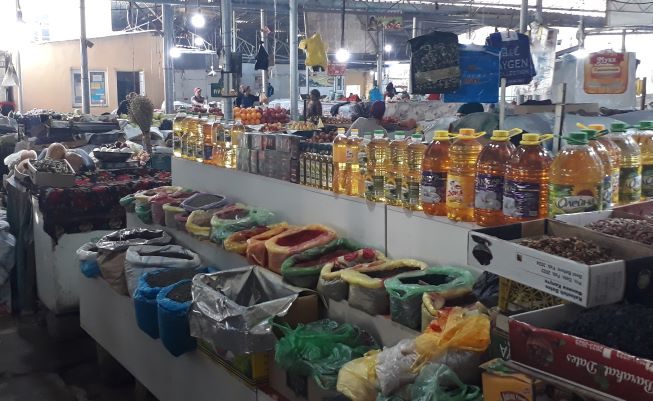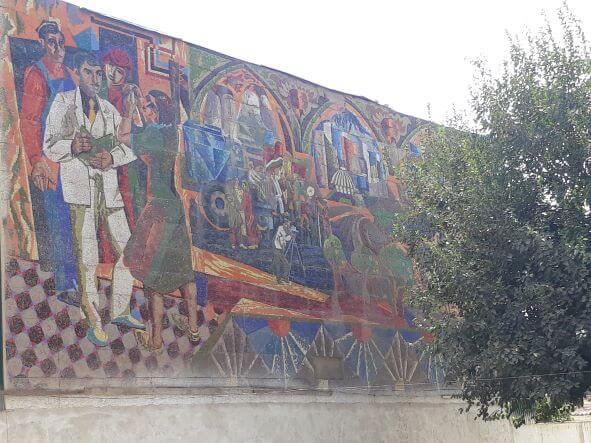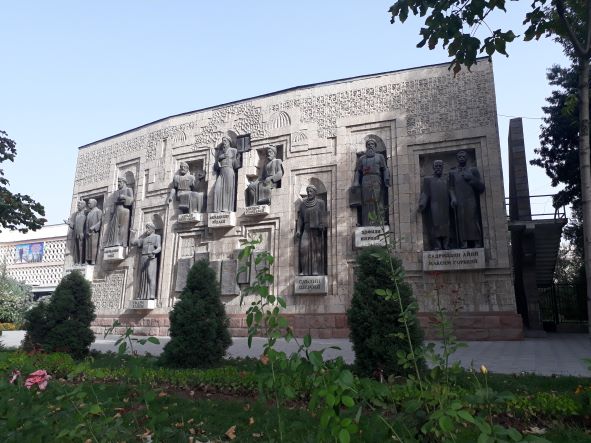- Reminisces: The Tajikistan I Knew and Miss
- The New Face of Tajikistan
«Ватанатро дӯст дор, лекин ҳақиқатро фаромӯш накун.»
Ҳошим Гадо
Oh, to remember truth and beauty…
Fourteen years ago, my wife and I lived in Tajikistan, and we made a week visit recently. Our guest house located within one of the high-rise apartments in the former Barakat Bazaar area recalled many of our memories. One of my favorite bazaars, as the merchants were so kind and welcoming. I got my feet wet with Tajiki in this bazaar, especially with my honey-selling friends. On one of my first visits there, the Toki-wearing man invited me to sit with him behind the stall, enjoying some fresh bread with his honey. He shared the area with another honey-seller who epitomized the Tajik Bobo. They were so welcoming that later on, my organization needed a video of life in Tajikistan. A portion of the short film presented Barakat Bazaar’s former hospitality to strangers like me.
Post-civil War Days
In those days, shortly after the civil war, bazaars demonstrated the limitation of goods in the country. We, as foreigners, often shared a find of canned goods or a shipment of carbonated apple juice that just came in from Dubai. As a father of a young four-month-old baby, part of my shopping list was finding Pampers for our son to alleviate the use of the cloth diapers which we were constantly washing. The struggle for a modern existence was confirmed.
Buildings on the beautifully lined Rudaki Street demonstrated the character of the Soviet period, where the rooms depicted the Stalinki style in the height of the ceilings.[1] https://www.rbth.com/society/2013/12/02/home_truths_about_soviet_design_32201.html For us, this made Western apartments feel so confiding. These old apartment complexes, which housed our oft-sick adjustment to life in this country in the summer of 1996, have been replaced by high rises. The capital started to build upward instead of a sprawling city toward Hissar or developing the Kafirnigan riverbed area. The character and personal sense of these older buildings created a raftu-omad intimate community, which the newer buildings challenge. However, I was pleased to see many buildings have a courtyard on the hidden side.
Visit to Khojent (Khujand)
Visiting Khojent reminded me of the Tajikistan I knew with the marked character of unique buildings and stores. I relished the individual yet community-welcoming shops that depicted the exact type of goods the place offered from the exterior. The necessity of progress sometimes ignores the treasure of the past warm community sense. Some lament the loss of the past, while others rejoice in the newness of these grand buildings.
The open-bazaar concept previously demonstrated the dire need of those selling household goods to buy bread for the evening. Or as I recall going to the daily bazaar below the beautiful Varzob mountains in Vaninasos, finding only a handful of eggs available for food since food shortages still existed in the summer of 1996, yet the friendliness of the people masked their neediness. This open bazaar started to develop as the months progressed, so a large gathering came each week to form what we called the Friday Bazaar. Today, this bazaar sits as it was: the meat and fruit sellers sit in the exact location they were 25 years ago. Unfortunately, I fear the newer ways of enclosing market space may diminish the cultural richness of the open bazaar.

Community Space Value
There is a challenge in developing a community space. How to link the past character with something new? The Soviet space value gave a conformed grandeur along with usefulness. As Tajikistan developed, I observed the Tajik social value of space depicted in their new high-rises. In these new high-rise apartments, their entry corridor models the Tajik courtyard in which each room is privately tucked behind the door so that a guest can only hope not to walk into the wrong room. On the frontage, geometric shapes border many windows to give at least an Islamic bent, but these buildings avoid the Tajik use of various colors. In seeing some of the older Soviet mosaics in old factories, the Soviets granted the use of Tajik color, but the modern architects seem to have their hands tied.

The Barakat Bazaar never was as crowded as the Zilloni Bazaar. Still, a possible miscalculation exists when they tore this unique intimate bazaar down and placed at least 2 to 3,000 individuals within its reach. Seeking simple items like tea and some milk created a treasure-like hunt into the neighborhood surrounding our apartment in 2022, only to find a former housing-ware makeshift metal building supplying the goods. I lamented the former spot, which sits empty with only rumble piled in places.

Betrayal for Personal Gain
On my return, I remember why we had to leave a country we loved. Two young men desiring promotion and a future acceptance into positions beyond them over-critiqued our existence publicly as Christians in the country. Their dishonest words forced the hand of the authorities to close up the avenues of help for orphans by using our relationship to attempt to build a future for themselves.
One entered the security sector, and the other is a well-known journalist today. Both sat in my home and spent hours talking together. I shared stories of truth with them but never pressured them to sell who they were as Tajiks. When one of these men won a highly prized University award, placing first in the country, a small group of us rejoiced with him at Chai Khaneh Rohat. His family was not there, nor were the future partners in the security system which would promote him – at that time, we rejoiced with him in his success. Regrettably, his future actions dishonored the concept of Tajik hospitality.

Unfortunately, their dishonest words shut down an organization that helped orphans in social homes. Depriving many of food help, social care, and moments of happiness they felt in our English Clubs, Ethics (Life) Club, and camps. We did these things in Tajik, promoting Tajik poetry and their culture. We did not come to change Tajikistan, but we knew God changes hearts no matter where one finds oneself.
The Fruit of our Efforts
Meeting up with some of these former students from the orphanages we helped, they now occupy positions of honor in the court system, leading figures in exposing smuggling and engineers in building their future. Their perspective summed up when we sat at Merve, the Turkish restaurant our kids loved in the late 1990s, with a former orphan whose distant relatives dropped him off as a six-year-old, never picked up again, kept calling my wife Ocha Jon (Dear Mom). Their respect channeled deeply as the past relationships continued till today.
Another young man said over tea in his house, As long as I live, I will always treasure the time at camp with your organization. The memories of the joy and fun will never leave me. In all my years at the Social Home (Internat) and even after, no other organization or agency cared to take us to a camp for five days. Our work never lost, and the intent to use a relationship for personal gain did not gain its full effect. Much like Joseph said to his brothers, I say to my manipulating friends, “As for you, you meant evil against me, but God meant it for good, to bring it about that many people should be kept alive, as they are today.” (Genesis 50:20, ESV).
Remembering
Today, our former campers, in circles of debate with others about ethics and religion, reference the key verse that the Life Club Camps promoted: He who does not love, does not know God because God is love. (1 John 4:8). This summarized our intent that others would come to know this God of love as well as learn how to love.
«Роҳи муҳаббат раҳи дуру дароз, ҳаст дар ин роҳ гарон бори ноз» (Муҳаммад Ғоиб)[2]Other Tajik quotes are found on www.dardidil.com
Check out my visit to the Khujand Museum.
References
| ↑1 | https://www.rbth.com/society/2013/12/02/home_truths_about_soviet_design_32201.html |
|---|---|
| ↑2 | Other Tajik quotes are found on www.dardidil.com |
Leave a Reply